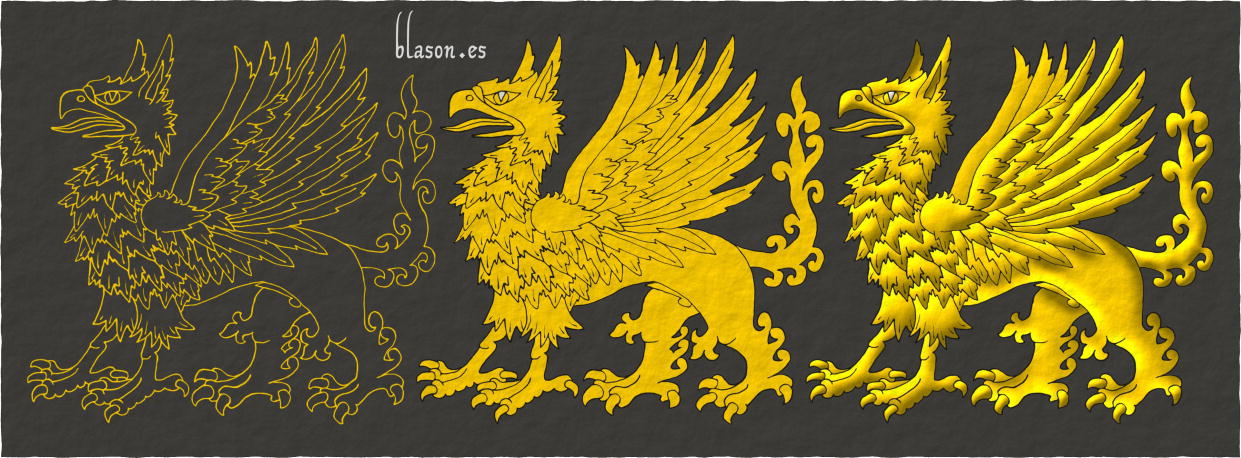Symbolism


![Ver [Bakala, K.; 2010] en referencias bibliográficas. Libro abierto, hojas de plata, filo de oro, guardas de gules, tapas de sable.](../css/Libro.Bibliografia.png)
Bakala, K.; 2010
Krzysztof Bakala, «Historia symboliczna: znakiem, herbem i barwa pisana : podreczny slownik» ~ «Symbolic history: written, emblem and color: handy dictionary», edited by Agencja Wydawnicza Egros, 198 pages, Warsaw, 2010.
Color sobre color
Sable and Purple exception on page 17: «nie pozwala nakladania metalu na metal, a barwy na barwe, za wyjatkiem barwy czarnej i purpurowej.» ~ «does not allow to put metal on metal and color on color, except the color Sable and Purpure»,
Bibliographical reference of century XXI.
Classification: Symbolism and Polish language.
Author: Bakala, Krzysztof.
The following article cites this bibliographic reference:
External link:


![Ver [Conway, D. J.; 2018] en referencias bibliográficas. Libro abierto, hojas de plata, filo de oro, guardas de gules, tapas de sable.](../css/Libro.Bibliografia.png)
Conway, D. J.; 2018
D. J. Conway, «Magickal, Mystical Creatures: Invite Their Powers into Your Life», 272 pages, published by Llewellyn Publications, Woodbury, 2018.
Index of fabulous beasts
- Unicorns, page 15, including Ki-Rin, Sin-You, Karkadann, Goat-Unicorns, Winged Sea-Unicorns;
- Flying Horses, page 29, including Pegasus, Winged Sea-Pegasus, Arabian-Burak, Sleipnir, Alsvidr, Arvakr;
- Centaurs, page 39;
- Satyrs and Fauns, page 51, including Jack in the Green, Pan, Urisk;
- Gigantic Birds, in the page 63 the part I begins and in the page 71 the part II begins;
- Human-Birds, page 79, including Garuda, Tengu, Egyptian Ba;
- Griffins, page 89, including Griffin-Demons, Hippogriff, Senmurv, Simurgh;
- Mystical Bulls and Bull-Men, page 99;
- Fabulous Lions, page 105;
- Magical Serpents, page 115;
- Riddling Sphinx, page 131;
- Mad Dogs and Hell Hounds, page 137;
- Water-Folk, page 153;
- Creatures of the Stony Stare, page 183;
- Gargoyles, page 189;
- Other Magical, Mythical Creatures, page 197.
Bibliographical reference of century XXI.
Classification: Symbolism, In black and white and English language.
The author is Conway, Deanna D. J..
External resource:


Eugene McCarthy, sealed
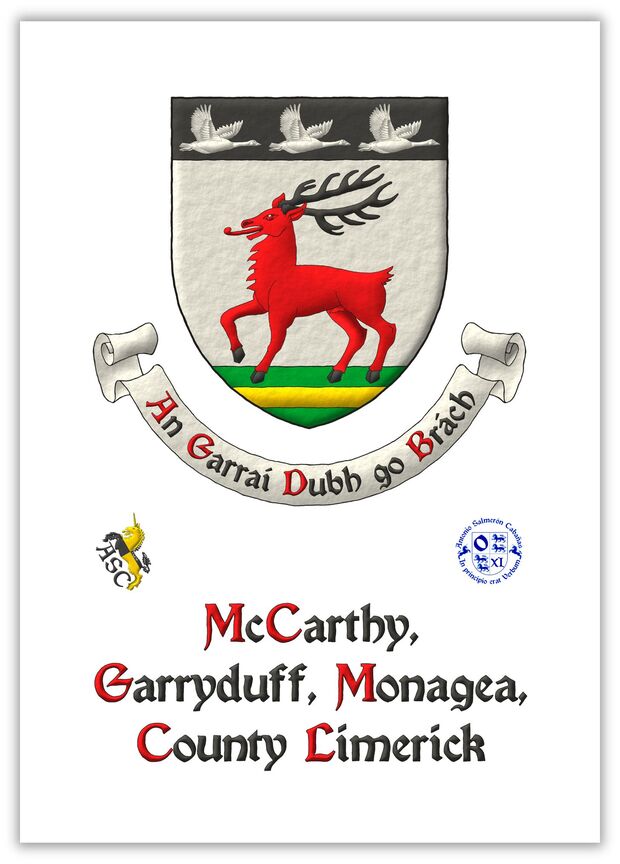
Argent, a stag trippant Gules, attired and hoofed Sable, standing on a terrace in base Vert charged with a fess Or; on a chief Sable, three geese volant contourné Argent. Motto: «An Garraí Dubh go Brách» Sable, with initial letters Gules, over a scroll Argent.
Design rationale
- The stag trippant Gules came from the arms of the MacCarthy clan, also transcribed as McCarthy, but for difference attired and hoofed Sable, this Sable reflecting the peat-coloured soil of Gerryduff.
- The chief Sable also from Garryduff, called «An Garraí Dubh» in Irish, which means «the black garden», referring to the peat-coloured dark soil; it is the home place of Eugene McCarthy and his family for generations.
- The three geese volant Argent from the local parish of Monagae, «the bogland of the geese», and they are flying to sinister as the Irish people from the US return to their Ireland, flying east across the Atlantic Ocean, this symbolism also evokes the famous «Wild Geese» Irish of previous centuries who emigrated to mainland Europe and further afield to serve in the armies of France, Spain, and Austria, many of the name McCarthy included.
- A terrace in base Vert with a fess Or because these are the colours of the local GAA* football and hurling club, established in 1896, GAA means Gaelic Athletic Association.
- And the motto «An Garraí Dubh go Brách» means «Garryduff Forever».
Blazon keywords: Argent, One, Stag, Passant, Gules, Attired, Hoofed, Sable, Terrace in base, Base, Vert, Charged, Fess, Or, Chief, Three, Goose, Volant and Facing sinister.
Style keywords: Outlined in sable and Pointed.
Classification: Personal, Interpreted, Coat of arms and Symbolism.
Bearer: McCarthy, Eugene.


Kathleen Kane, sealed
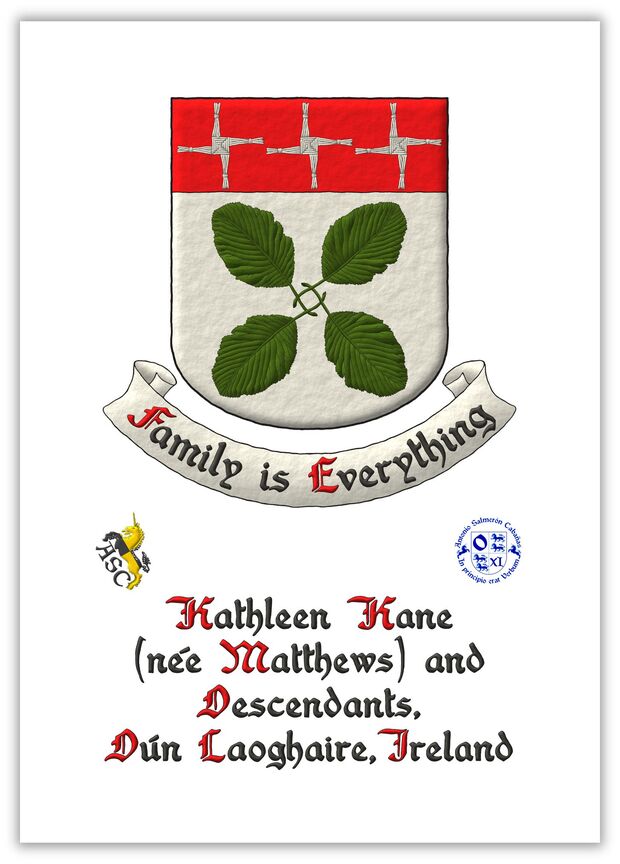
Argent, four leaves of Silver Leaved Whitebeam (Sorbus Aria Lutescens) in saltire, stems interlaced Vert, on a chief Gules, three crosses of Saint Brigid Argent. Motto: «Family is Everything» Sable, with initial letters Gules, over a scroll Argent.
Design rationale
Kathleen Kane's three recent matrilineal ancestors were all named after the Irish Saint Brigid of the 5th and 6th centuries. With the time, this saint added to her own story some of the characteristics of her namesake, the earlier Celtic goddess of water, poetry, and the alchemical force of fire. She is one of the patron saints of Ireland and her Feast Day is February 1st.
These three women were formidable characters: resilient, resourceful, and independent. Each inspired their daughters to follow in their footsteps, reflecting the attributes associated with Saint Brigid, an icon of strength, piety, resourcefulness, and independence. They are symbolized by the three crosses of Saint Brigid.
Saint Brigid's Crosses, woven from straw or rushes and blessed, are traditionally hung in the rafters or beams of the house to ensure the saint's protection throughout the year for all household members. This symbolism connects the matrilineal ancestors with the home and the protection of the family, which, according to the motto, is everything.
The four leaves of the Silver Leaved Whitebeam represent Kathleen's four children. The interlaced stems symbolize the union of the family and their home in Dún Laoghaire, outside of which this tree grows.
Blazon keywords: Argent, Four, Leaf, In saltire, Stem, Interlaced, Vert, Chief, Gules, Three and Cross of Saint Brigid.
Style keywords: Outlined in sable and Rounded.
Classification: Personal, Interpreted, Coat of arms and Symbolism.
Bearer: Kane, Kathleen.


![Ver [Marecki, J.; 2012] en referencias bibliográficas. Libro abierto, hojas de plata, filo de oro, guardas de gules, tapas de sable.](../css/Libro.Bibliografia.png)
Marecki, J.; 2012
Józef Marecki, «Barwa w heraldyce» ~ «Color in heraldry», [Redakcja, P.; Mareckiego, J.; Rotter, L.; 2012; páginas 65-81], edited by Wydawnictwo Naukowe ~ Scientific Editorial of la Uniwersytet Papieski Jana Pawla II, 17 pages, Cracow, 2012.
Bibliographical reference of century XXI.
Classification: Symbolism, In black and white, Polish language and Article.
The author is Marecki, Józef.
The following article cites this bibliographic reference:


Margaret Byrne, sealed
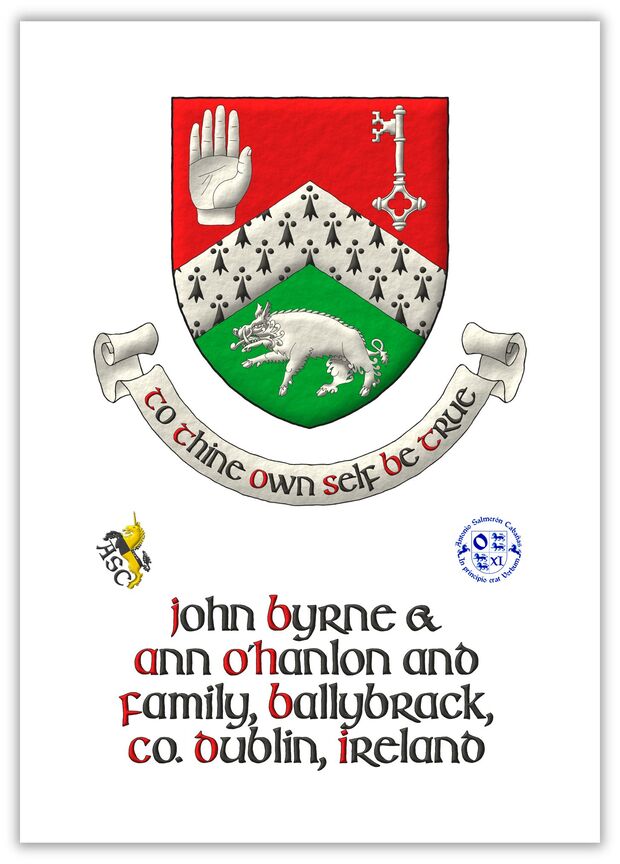
Party per chevron Gules and Vert, overall a chevron ermine between, in the dexter of the chief a dexter hand apaumée couped at the wrist, in the sinister of the chief a key palewise, ward to dexter chief, and in base a boar passant Argent. Motto: «To Thine Own Self Be True» Sable, with initial letters Gules, over a scroll Argent.
Design rationale
This design combines Byrne, O'Byrne, Ó Broin arms: «Gules, a chevron between three dexter hands apaumée couped at the wrist Argent», with O'Hanlon, Ó hAnluain arms: «Vert, on a mount in base proper, a boar passant Ermine».
These features embody the heraldic adaptation by Gaelic chieftains, integrating ancient tribal symbolism deeply rooted in Celtic mythology and rich local traditions from Wicklow and Armagh.
This design, while combining elements from each and respects this symbolism:
- The layout of the traditional Byrne arms was chosen as the basis for the new arms to reflect the armiger's surname, however, for difference only one of the three dexter hands is employed but in the prime dexter position on the shield and retaining its tinctures. The sinister position has a key to emphasise and reflect the motto «To Thine Own Self Be True» as the essential or key message for one's life, integrity and honesty.
- The base of the shield has the boar taken from the O'Hanlon arms, an ancient symbol of bravery, courage, and tenacity.
- The chevron ermine was chosen to incorporate an element used in various versions of the Byrne and O'Hanlon traditional arms and to reflect the nobility of these two ancient clans/septs who fought long and hard to maintain their independence right up to the XVII century.
Blazon keywords: Party per chevron, Gules, Vert, Overall, One, Chevron, Ermine, Between, Dexter, Chief, Hand, Appaumée, Party per fess, Wrist, Sinister, Key, Palewise, Key ward, Base, Boar, Passant and Argent.
Style keywords: Outlined in sable and Pointed.
Classification: Personal, Interpreted, Coat of arms and Symbolism.
Bearer: Byrne, Margaret.


![Ver [Redakcja, P.; Mareckiego, J.; Rotter, L.; 2012] en referencias bibliográficas. Libro abierto, hojas de plata, filo de oro, guardas de gules, tapas de sable.](../css/Libro.Bibliografia.png)
Redakcja, P.; Mareckiego, J.; Rotter, L.; 2012
Pod Redakcja, Józefa Mareckiego y Lucyny Rotter, «Symbol - Snak - Przeslanie: Barwy i Ksztalty» ~ «Symbol - Sign - Message: Color and Shape», edited by Wydawnictwo Naukowe ~ Scientific Editorial of the Uniwersytet Papieski Jana Pawla II, 179 pages, ISBN 978-83-7438-321-9 Cracow, 2012.
Bibliographical reference of century XXI.
Classification: Symbolism, In black and white and Polish language.
Authors: Redakcja, Pod, Mareckiego, Józefa and Rotter, Lucyny.
The following article cites this bibliographic reference:
External resources:
Internal resources: RedakcjaPMareckiegoJRotterL2012.33.SymbolSignMessageColorShape.pdf PDF document in Polish.


![Ver [Wade, W. C.; 1898] en referencias bibliográficas. Libro abierto, hojas de plata, filo de oro, guardas de gules, tapas de sable.](../css/Libro.Bibliografia.png)
Wade, W. C.; 1898
William Cecil Wade, «The symbolisms of heraldry or A treatise on the meanings and derivations of armorial bearings», 186 pages, 95 black and white pictures, Robert Holmes Collection, published by George Redway, London, 1898.
Although Romanticism sought the symbolism of the heraldic elements, I believe that the meaning of the elements of the coat of arms, if they have it, is provided by its creator or first bearer. In any case, the content of this symbolic book is the following:
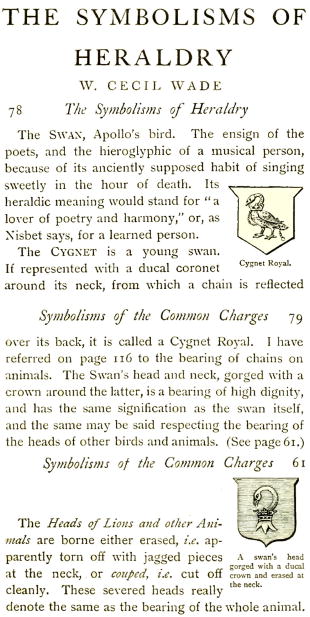
- The origin of armorial bearings; page 11.
- The symbolic side of heraldry; page 13.
- Heraldic colors and metals; page 35.
- The furs of heraldry; page 38.
- The meaning of heraldic lines; page 40.
- The symbolisms of the ordinaries; page 43.
- The division lines of the shield; page 55.
- The colors of the common charges not symbolical, chapter with 2 paragraphs only; page 57.
- Symbolisms of the common charges; page 59.
- Crowns, mitres, episcopal hats, etc.; page 138.
- Examples of symbolisms of colors and armorial bearings; page 149.
- Cadency and differencing; page 154.
- Alphabetic index; page 162.
Bibliographical reference of century XIX.
Classification: Symbolism, In black and white and English language.
Author: Wade, William Cecil.
The following article cites this bibliographic reference:
External resource:
Internal resources: WadeWC1898.SymbolismsHeraldry.pdf.
-
Language
-
Categories of heraldry
-
Divisions of the field
- Without divisions
- Party per pale
- Party per fess
- Party per bend sinister
- Tierce
- Tierce sinister
- Tierced per bend
- Quarterly
- Quarterly per saltire
- Gyronny
- Party per fess, the chief per pale
- Party per pale, the sinister per fess
- Party per fess, the base per pale
- Party per pale, the dexter per fess
- Party per chevron
- Indented
- Enté en point
- Flanched
-
Metals
-
Colours
-
Furs
-
Other tinctures
-
Ordinaries and sub-ordinaries
-
Diminutives of the ordinaries
-
Other charges
-
Charges from Nature
Eagle, Two hands clasped, Lark, Tree, Rainbow, Trunk of a tree, Atom, Barbel, Acorn, Arm, Owl, Horse, Head, Thistle, Stag, Doe, Crescent, Increscent, Tail, Heart, Roe deer, Neck, Roe deers' attires, Raven, Dolphin, Diamond, Tooth, Elephant, Starling, Mullet, Estoile, Male figure, Fleur de lis, Hop cone, Puffin, Ash, Paw, Goose, Seagull, Pomegranate, Sunflower, Falcon, Leaf, Flame, Boar, Barn owl, Lion, Lioness, Lion passant, Leopard, Lion rampant guardant, Lynx, Lily, Wolf, Hand, Apple, Martlet, Wing, Two wings in vol, Covert, Mount, Trimount, Wrist, Orbital, Bear, Palm tree, Poplar leaf, Paw, Peacock, Chest, Dog, Brach hound, Fish, Hoof, Quill, Cinquefoil, Quetzal, Branch, Oak, Rose, Double rose, Serpent, Sun in splendour, Ray of the sun, Stem, Wheat, Wheat spike, Bull, Tulip, Udder, Escallop and Fox.
-
Artificial charges
Halberd, Plough share, Ace of spades, Cyclamor, Torch, Harp, Non-classic artifact, Ship, Beret, Grenade, Ecclesiastical cap, Chain, Covered cup, Bell tower, Cannon dismounted, Carbuncle, Castle, Clarion, Nail, Cord, Dagger, Key ward, Turret, With a turret, Sword, Sabre, Scroll, Arrow, Garb, Gauntlet, Buckle, Spear, Spear's head, Letter, Book, Line, Key, Four crescents joined millsailwise, Hammer, Menorah, Number, Knot, Celtic Trinity knot, Parchment, Piano, Millstone, Millrind, Millwheel, Bridge, Hourglass, Chess rooks, Compass rose, Rosette of acanthus leaves, Mullet of six points pierced, Portcullis, Wheel, Wagon-wheel, Symbol, Sackbut, Drum, Tower, Trident, Double vajra and Anvil.
-
Immaterial charges
Angel, Heart enflamed, Sacred Heart of Jesus, Paschal lamb, Dragon, Phoenix, Griffin, Winged hand, Pegasus, Saint George, Trinity, Triton, Golden fleece and Unicorn.
-
External elements
-
Heraldic creations
-
References
-
Formats
-
Keywords on this page
Between, Pointed, Bibliography, Overall, Byrne, Margaret, Chevron, Base, Charged, Stag, Colour on colour, Party per fess, Cross of Saint Brigid, Four, Outlined in sable, Key ward, Dexter, In black and white, In saltire, Interlaced, Coat of arms, Fess, Goose, Personal, Gules, Interpreted, Boar, Chief, Kane, Kathleen, English language, Polish language, Key, Hand, Party per chevron, McCarthy, Eugene, Wrist, Or, Passant, Argent, Palewise, Base, Attired, Rounded, Sable, Century XIX, Century XXI, Symbolism, Vert, Three and One.
